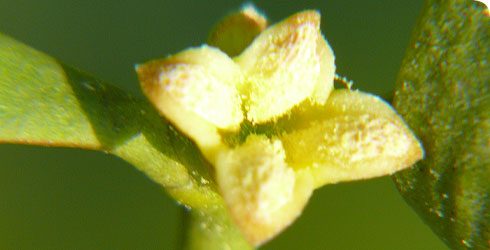Taxonomy
Mistletoe is an evergreen and somewhat woody plant, sometimes referred to as a shrublet.
It grows up to 1m high, with numerous, regularly forked branches.
The stem grows without branching for the first 3 or 4 years. The shoot then branches once per year, so the approximate age of a mistletoe can be calculated by counting the number of forks in the stem and adding 3.
The leaves are borne in pairs, each leaf 5–7cm long, widest above the middle, narrowly oval and slightly curved in outline. They are matt yellowish-green in colour and have a distinctive leathery texture.
The flowers are fly pollinated and are very small and inconspicuous,appearing from February to April in clusters of 3 to 5. Male and female flowers are borne on different plants. Both sexes have 4 small, yellowish green petals - the sepals of female flowers are extremely small and are completely absent in male flowers.
The waxy berries are 1cm in diameter, white and sticky and are only produced by female plants. They ripen in November and December. Birds eat the berries and disperse the seeds, but the berries are poisonous to humans.
As a species, Viscum album is often subdivided into 4 groups variously ranked as either subspecies, varieties or genetic races. These have different host trees, 2 of them on species of spruce, 1 on species of pine and the most widespread on deciduous tree species.
Evolution
The parasitic habit has evolved separately in several plant families:
- Mistletoes which are hemi-parasites - plants which take some of their nutrients from the host but are capable of manufacturing at least some of their own food. All mistletoes are shrubs or shrublets, parasitic on trees.
- Members of the closely-related family Loranthaceae are also hemi-parasites - they may be shrublets, shrubs, lianes or trees, and grow on a wide variety of hosts. Nuytsia floribunda, (the Christmas tree of Australia) is a tree growing up to 12m high and is parasitic on the roots of many plants, including grasses.
